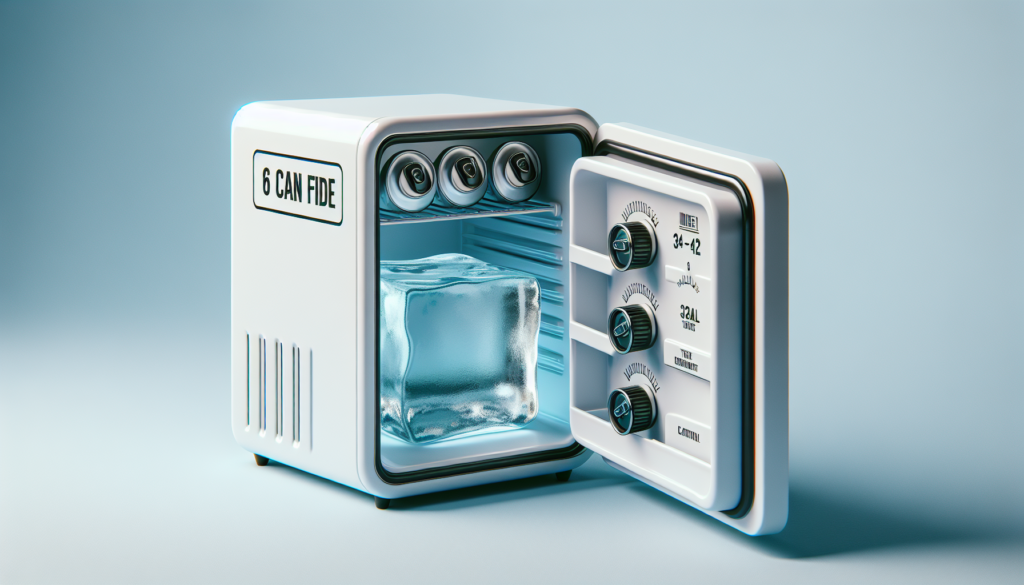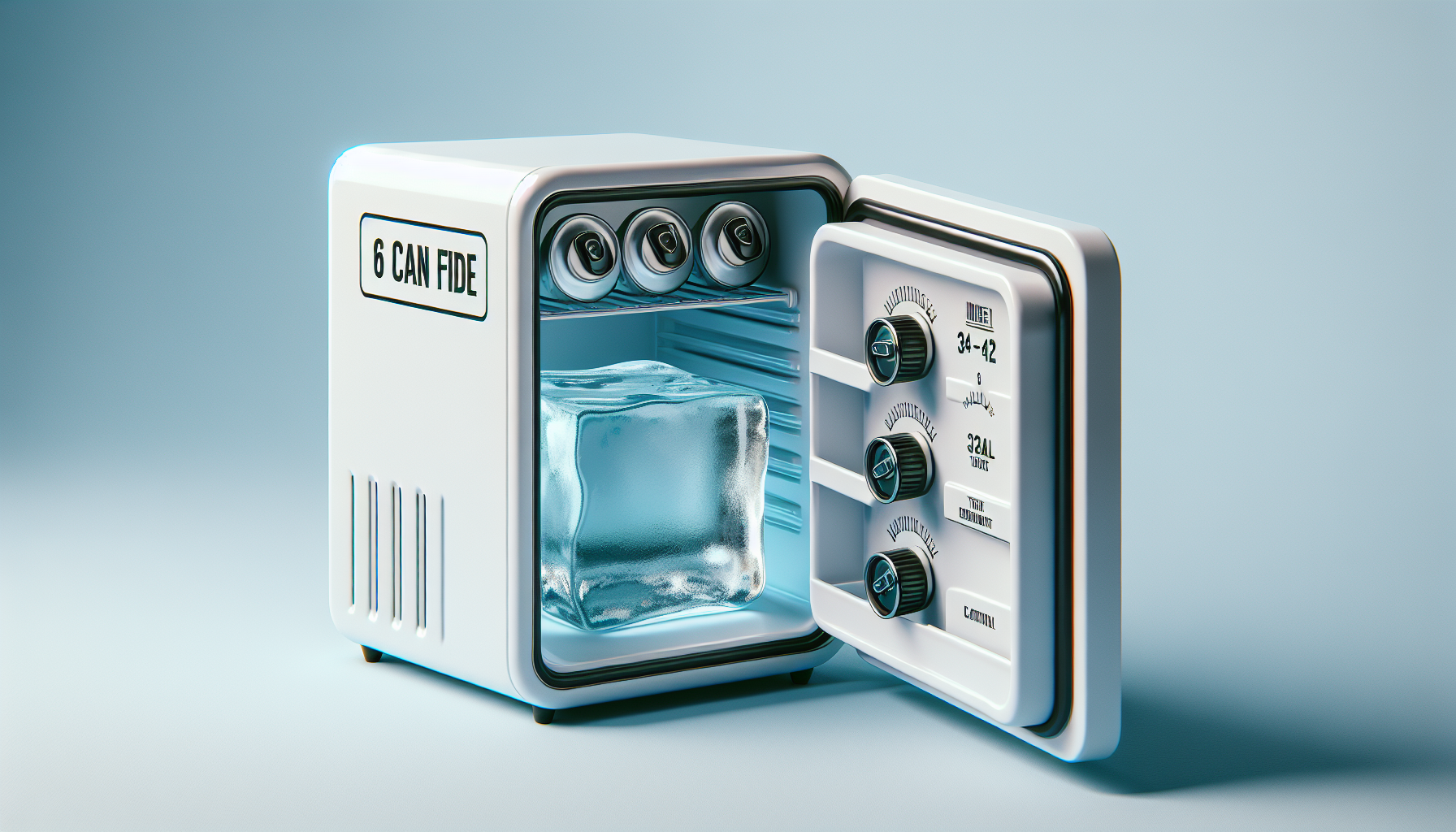Have you ever wondered just how cold a 6 can mini fridge can actually get? Well, get ready to be amazed as we take a closer look at the temperature capabilities of these handy little appliances. From chilling your favorite beverages to storing snacks at an optimal temperature, the 6 can mini fridge has become a staple for many. But just how cold does it really get? Let’s find out!

CHECK OUT MINI FRIDGES AND KEGERATORS ON AMAZON
Factors Affecting Temperature Range
When it comes to the temperature range of a 6 can mini fridge, there are several factors to consider. Understanding these factors will help you optimize the cooling efficiency of your mini fridge and ensure that it meets your specific needs. The main factors that affect temperature range are cooling technology, insulation, ambient temperature, and thermostat settings. Let’s take a closer look at each of these factors and how they impact the temperature range of your mini fridge.
Cooling Technology
The type of cooling technology used in your mini fridge plays a crucial role in determining its temperature range. There are two main types of cooling technology commonly used in mini fridges: compressor-based and thermoelectric.
Compressor-based Mini Fridges
Compressor-based mini fridges work by using a compressor and refrigerant to cool the contents inside. These mini fridges are known for their ability to achieve low temperatures, making them ideal for keeping beverages and perishable items cool. They can typically reach temperatures as low as 32°F (0°C) or even lower.
Thermoelectric Mini Fridges
Thermoelectric mini fridges, on the other hand, use a different cooling technology known as the Peltier effect. These mini fridges are generally more compact and energy-efficient but may have a higher temperature range compared to compressor-based fridges. The temperature range of thermoelectric mini fridges typically hovers around 39°F to 59°F (4°C to 15°C).
Insulation
The quality and thickness of insulation in your mini fridge also impact its temperature range. Good insulation is essential for retaining cool air inside the fridge and preventing warm air from seeping in.
Quality of Insulation
A mini fridge with high-quality insulation will have better temperature control and be more energy-efficient. Look for mini fridges with insulation materials like polyurethane foam, which is known for its excellent insulating properties.
Thickness of Insulation
Thicker insulation can provide better temperature control by minimizing heat transfer between the internal and external environments. Mini fridges with thicker insulation may have a narrower temperature range and better cooling efficiency.
Ambient Temperature
The ambient temperature in the room where your mini fridge is located can have a significant impact on its cooling performance. If the surrounding temperature is high, it can make it more challenging for the mini fridge to cool its contents to lower temperatures.
How the Surrounding Temperature Affects Cooling
When the ambient temperature is high, the mini fridge’s cooling system has to work harder to maintain a lower internal temperature. This increased workload can result in a wider temperature range and potentially affect the cooling efficiency of the fridge. It’s important to place your mini fridge in a well-ventilated area away from direct sunlight and other sources of heat to optimize its cooling performance.
Thermostat Settings
The thermostat settings of your mini fridge directly control the temperature at which it operates. Understanding the thermostat options and accuracy is crucial for achieving the desired temperature range.
Variable Temperature Ranges
Some mini fridges offer adjustable thermostat settings, allowing you to set a specific temperature within a given range. These variable temperature ranges give you more control over the cooling process and allow you to customize the fridge’s temperature based on your needs.
Thermostat Accuracy
The accuracy of the thermostat is also important. A mini fridge with a more accurate thermostat will have better temperature control, resulting in a narrower temperature range and more consistent cooling.
Temperature Range of 6 Can Mini Fridges
Now that we have explored the factors that impact the temperature range of mini fridges let’s focus on the specific temperature range you can expect from a 6 can mini fridge.
General Temperature Range
A 6 can mini fridge typically offers a temperature range between 32°F to 59°F (0°C to 15°C), depending on the cooling technology, insulation, ambient temperature, and thermostat settings. It’s important to note that this is a general range, and individual models may have slight variations in their temperature range capabilities.
Typical Cooling Limits
While a 6 can mini fridge can cool its contents to temperatures as low as 32°F (0°C), it may not have the same cooling capacity as larger fridges. Therefore, you may notice that the cooling efficiency decreases when the fridge is filled with a larger number of cans or if the ambient temperature is high. It’s essential to understand the limits of your mini fridge and make adjustments accordingly.
Tips to Optimize Cooling Efficiency
To ensure that your 6 can mini fridge operates at its optimal cooling efficiency, there are several tips you can follow:
Proper Placement of Mini Fridge
Place your mini fridge in a well-ventilated area away from direct sunlight and other sources of heat. This will help maintain a suitable ambient temperature and prevent the fridge from working harder than necessary.
Maintaining a Suitable Ambient Temperature
Keep the room temperature around the mini fridge at a comfortable level. If the room temperature is too high or fluctuates significantly, it can impact the fridge’s cooling performance.
Avoiding Overfilling the Fridge
Try not to overfill your mini fridge as it can obstruct air circulation and reduce the cooling efficiency. Leave enough space around the cans to allow proper airflow.
Closing the Door Properly
Ensure that the mini fridge’s door is tightly closed at all times. An improperly closed door can lead to significant air leakage and compromise the cooling efficiency.
Minimizing Door Opening Frequency
Avoid frequent opening and closing of the mini fridge door, as it allows warm air to enter and affects the temperature inside. Plan ahead and retrieve all the items you need in one go to minimize the door opening frequency.
Potential Issues
While 6 can mini fridges are convenient and reliable, there are a few potential issues that you may encounter:
Inconsistent Cooling
If you notice inconsistent cooling in your mini fridge, it could be due to factors such as a faulty thermostat, inadequate insulation, or poor placement. Checking these factors and addressing any issues can help improve cooling consistency.
Cooling Insufficiency
In some cases, a 6 can mini fridge may struggle to cool its contents sufficiently, especially in high ambient temperatures or if it is overfilled. If you find that your mini fridge is not achieving the desired temperature, consider reducing the number of cans or relocating the fridge to a cooler area.
CHECK OUT MINI FRIDGES AND KEGERATORS ON AMAZON
FAQs
Here are some frequently asked questions about 6 can mini fridges:
Can a mini fridge freeze beverages?
While a 6 can mini fridge can achieve temperatures close to freezing, it may not be designed to freeze beverages completely. The primary function of a mini fridge is to cool beverages and perishable items, keeping them at a refreshing temperature.
How long does it take for a mini fridge to cool?
The time it takes for a mini fridge to cool its contents can vary depending on factors such as the initial temperature of the items, ambient temperature, and the cooling technology of the fridge. On average, it can take a few hours for a mini fridge to reach its desired temperature.
How can I increase the cooling capacity of my mini fridge?
To increase the cooling capacity of your mini fridge, you can follow the optimization tips mentioned earlier, such as proper placement, suitable ambient temperature, avoiding overfilling, closing the door properly, and minimizing door opening frequency.
Conclusion
Understanding the factors that affect the temperature range of a 6 can mini fridge is essential for maximizing its cooling efficiency. By taking into account the cooling technology, insulation, ambient temperature, and thermostat settings, you can optimize the performance of your mini fridge and achieve the desired temperature for your beverages. Remember to follow the tips provided to ensure that your mini fridge operates at its best, and consult the FAQs for additional information on common queries related to 6 can mini fridges.

